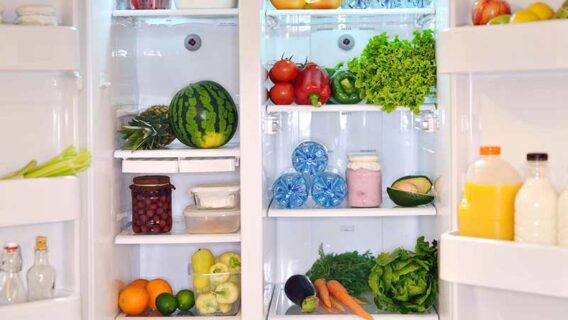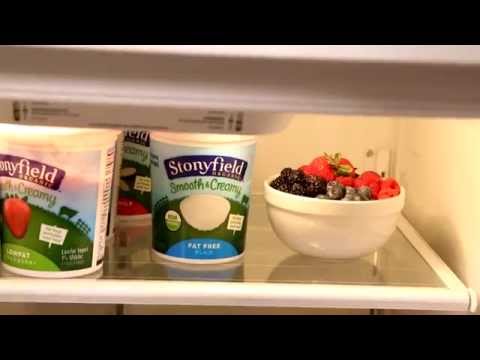Discover the secrets to transforming your fridge into a haven of nutrition and wellness.
The key to stocking your fridge with healthy food lies in strategic planning, choosing fresh produce, prioritizing whole foods, and organizing your space for easy access to nutritious choices.
In this guide, we’ll unveil simple steps to ensure your fridge is always filled with health-boosting options, making it easier for you to make healthier choices every day.

Let’s embark on this journey to a healthier you by starting with what’s in your fridge.
Clear Out Less Healthy Items
The first step to stocking your fridge with healthy foods is to clear out less nutritious items.
Go through your fridge and look for foods that are highly processed and high in unhealthy fats, added sugars, or sodium. Some examples of less healthy foods to remove include:
- Sugary drinks like soda, fruit punch, sports drinks, etc.
- Processed snacks like chips, cookies, candy, etc.
- High-fat dairy items like regular/full-fat cheese, sour cream, etc.
- High-sodium condiments like soy sauce, barbeque sauce, salad dressings, etc.
By removing tempting junk foods and beverages, you reduce unhealthy options and open up space for healthier items.
Fill Your Fridge With Fruits And Vegetables
Fruits and vegetables should take up a good portion of space in your fridge. They provide essential vitamins, minerals, fiber, and plant compounds vital for good health.
Some healthy fruits and veggies to stock up on include:
- Fruits: apples, bananas, berries, grapefruit, grapes, oranges, peaches, pears
- Vegetables: broccoli, carrots, cauliflower, celery, cucumbers, leafy greens like spinach and kale, mushrooms, peppers, sweet potatoes, tomatoes
Tips for Storage:
- Store delicate berries on middle fridge shelves, avoid stacking too high
- Keep leafy greens in high-moisture drawers
- Store apples, citrus, bananas on countertop away from light if no room in fridge
- Wash, dry, chop and store veggie prep for easy grab-and-go snacks
Having washed and prepped veggies on hand makes it easier to eat healthy when rushed.
Choose Healthy Proteins
Protein foods are essential for building and repairing muscle tissue, supporting immune function and keeping you feeling full between meals.
Healthy protein options to stock your fridge with include:
- Lean Meats: chicken breasts, 93% lean ground turkey, lean cuts of beef like sirloin, pork tenderloin
- Fish/Seafood: salmon, tuna, cod, shrimp, crab, mussels
- Eggs and Egg Substitutes: cage-free omega-3 eggs, egg whites, tofu
Tips for Storage:
- Store raw meats on bottom shelf to prevent juices from dripping
- Freeze if not using within 2 days, thaw overnight in fridge before using
- Hard boil eggs to keep in fridge for easy high-protein snacks
Choosing leaner cuts of meat and plant-based proteins provides plenty of protein without excess saturated fats.
Incorporate Healthy Dairy
Dairy products provide protein, calcium, vitamin D, and other nutrients. Just be mindful of high-fat options that can lead to excess calorie and saturated fat intake when consumed in large portions.
Some smart dairy choices include:
- Milk/Yogurts: nonfat milk, low-fat (1%) milk, unsweetened soy/almond milk, nonfat Greek yogurt
- Cheeses: low-fat cottage cheese, part-skim mozzarella, feta, Parmesan
Tips for Storage:
- Choose plain dairy items rather than flavored yogurts and milk with added sugars.
- Stick to small portions of dairy servings to limit saturated fats.
- Buy cheese in portion-controlled packs or shred/dice into serving sizes right away
Opting for low-fat dairy allows you to benefit from essential nutrients without overdoing unhealthy fats.
Hydrate With Healthy Beverages
It’s essential to stay hydrated by drinking plenty of water and other healthy beverages each day. Skip sugary drinks like soda and juices and instead stock up on:
- Plain Water: Sparkling water for variety, infused with fruits and herbs
- Tea: Green, black, herbal (mint, chamomile) iced or hot
- Coffee: Limit added sweeteners and creamers
- 100% Fruit Juices: No added sugars, low-sodium – limit 4 oz daily
Tips for Storage:
- Brew tea by the pitcher and chill for easy access
- Prepare fruits/herbs for infusing water in advance
- Store nut milk refrigerated once opened, even if shelf-stable
Having ready-to-drink healthy beverages makes it simple to stay hydrated without lots of added sugars.
Add Healthy Fats In Moderation
Healthy fats are an important part of a balanced diet, providing essential fatty acids and helping with the absorption of fat-soluble vitamins. Be mindful of portions, as even healthy fats are high in calories.
Good Fats to Include:
- Avocados – Beneficial monounsaturated fats
- Nuts – Walnuts, almonds, pecans
- Nut Butters – Look for no added sugars/oils
- Seeds – Flax, chia, hemp
- Oils – Olive, avocado, grapeseed – For cooking and dressings
Tips for Storage:
- Store nuts, seeds, and nut butter in the fridge or freezer to maintain freshness
- Transfer nut oils to small containers if not using quickly to limit spoilage
- Limit fat intake to 2-3 servings per day
Choosing mostly unsaturated plant fats provides health benefits without going overboard on less healthy saturated fats that can increase cholesterol levels.
Read Labels For Added Sugars
Make sure to read food labels when stocking your fridge to avoid items with excessive added sugars, a common culprit in ultra-processed foods.
Some surprising sources of added sugars include:
- Flavored yogurts and oatmeals
- Granola bars and cereals
- Jarred sauces like pasta sauce, barbecue sauce
- Salad dressings and condiments
- Packaged snacks like crackers, protein bars
Ideally, aim for:
- 5g or less sugar per serving
- No added sugars in the ingredients list
- Minimal ingredients overall
Checking labels helps minimize hidden sources of added sugar in even seemingly “healthy” products.
This helps balance blood sugar levels, which is essential for appetite control and sustained energy levels.
Prepare Healthy Snacks In Advance
Having ready-to-eat healthy snacks in your fridge prevents you from grabbing less nutritious convenience options when hunger hits.
Some easy snacks to prepare include:
- Veggies and hummus – Store in individual containers.
- Cottage cheese and fruit – Combine for balanced protein-carb combo.
- Hard-boiled eggs – Cook up a half dozen at a time for easy protein.
- Tuna salad stuffed in tomatoes – Make tuna salad with light mayo stuff in cherry tomatoes.
- Healthy homemade trail mix – Mix nuts, seeds, chopped fruit, whole grain cereal.
- Greek yogurt parfaits – Layer yogurt, berries, sliced almonds.
Tips for prep:
- Designate containers or bags for planned portions
- Prep produce for easy grabbing, like washed grapes and baby carrots
- Cook once, eat twice – grill extra chicken for salads and wraps
Having healthy snacks readily available helps avoid trips to the vending machine or drive-thru when needing convenient options.
Read Best-By Dates
An essential final tip for keeping your fridge stocked is paying attention to best-by dates on perishable items like fresh produce, meats, and prepared foods.
Best-by dates indicate the timeframe in which the food’s quality is best, not necessarily when it expires and is unsafe to eat.
Here are some tips for storage based on best-by dates:
- Check dates when returning from the grocery store and plan to use them soon.
- Place items with the soonest dates in front.
- Follow the “First-In, First-Out” system by rotating new food items to back.
- Freeze extra meats/baked goods if won’t be consumed in time
- Compost expired produce and leftovers if they spoil before eating
Staying on top of best-by dates reduces throwing away spoiled foods and wasting money.
Continue Evaluating Fridge Contents
Evaluate fridge contents weekly when planning meals/grocery shopping. Are fruits and veggies running low? What needs to be used soon?
Taking stock ensures you have what you need to assemble healthy meals and snacks for the week ahead.
Over time, you will establish a pattern for what staple ingredients work for your household. This makes the process of stocking a nourishing fridge second nature.
The simple habit of regularly evaluating fridge contents is essential for maintaining a supply of fresh, wholesome foods ready for enjoying.
Conclusion
Stocking your fridge with nutritious whole foods is essential for supporting a healthy lifestyle long-term.
It does take some planning, but the payoff of having the right foods readily available when you need them is well worth the effort upfront.
Start by clearing out less healthy items, so you have space for healthier substitutions like fruits, vegetables, lean proteins, and low-fat dairy items.
Read labels to avoid sneaky sources of added sugars, and fill your fridge with balanced snacks you can grab when hunger hits.
Checking best-by dates and regularly taking stock of what you need from week to week helps streamline the process over time. Before you know it, having a fridge filled with wholesome foods will seem totally normal!
The simple act of transforming your fridge into a nourishing food source saves time and effort when it comes to assembling healthy meals for yourself or your family.
It also makes choosing nutritious options automatic since that is what is readily available at home.
So do yourself a healthy favor and take the appropriate steps to get your fridge food ready! Your body will thank you.
Here are some commonly asked questions about stocking your fridge with healthy food:
What are the healthiest foods I should have in my fridge?
Some of the healthiest foods to stock your fridge with include fruits, vegetables, lean proteins like chicken/fish/tofu, eggs, Greek yogurt, nuts/seeds/nut butter, whole grains, beans/lentils, and healthy oils like olive or avocado oil.
How can I organize my fridge to easily find healthy options?
Designate certain shelves/drawers for healthier categories – produce in bottom drawers, proteins together on a shelf, snack containers together on a shelf. Place healthier options front-and-center on eye-level shelves.
How often should I meal prep to have healthy homemade options on hand?
Ideally, set aside 1-2 hours over the weekend to batch-prep balanced meals and snacks like hard-boiled eggs, oven-roasted veggies, quinoa salad, and grilled chicken. This makes assembling healthy meals much quicker during the busy week.
What are good on-the-go healthy snacks I can store in my fridge?
Some tremendous portable fridge snacks include sliced apples with nut butter, Greek yogurt tubes, cottage cheese with fruit, rolled up sliced turkey and cheese, chilled cooked quinoa stuffed in peppers or tomatoes, and leftovers like roasted chickpeas or veg sides. Having pre-portioned grab-and-go options makes eating healthy away from home more realistic.
How can I prevent healthy fridge items from spoiling too quickly?
Store perishable fruits/veggies in high moisture drawers, keep leafy greens like spinach in air-tight containers, organize fridge using “first-in, first-out” system, move newer items to back, properly seal foods to prevent drying out and freeze extras like meat, bread, baked goods to prolong freshness. Checking best-by dates weekly ensures you use up items in time.

2 thoughts on “How To Stock Fridge With Healthy Food?”